I can recall in my early childhood the wonderful trips to Waterloo Village. Hopping into my father's 1936 Chevrolet, we drove down into the village for the annual Peach Festival. It was a social time with games and hayrides for children and, of course, you could wander down through the village to see where the canal boats once slid by. It was an intriguing thing. At that time, some of the buildings were still open such as Smith's General Store, the Blacksmith Shop and the Gristmill. These structures were high points in the life of Waterloo Village. The people who lived and ran businesses there depended heavily on them. From the Methodist church, where the yearly Peach Festival was held, we took a short hay wagon ride through the middle of the village passing these buildings. We then crossed over the old iron bridge with its wooden plank floor. I can still remember the click clack, click clack as the wheels of the wagon passed over it. We would take that wagon out through the back roads into the woods and return over the bridge to the main road and back through the rest of the village, taking all of 15 minutes. In a child's eyes, however, we were in the wild frontier of unknown territory for hours! It was loads of fun and, of course, when we got back, the peach cobbler, pie peach and peaches with ice cream were waiting for us and not to be missed.
One of key paintings I did of Waterloo Village was entitled: "Smith's Store". It was my first painting of this grand old building looking from the back where the canal boats would unload all their wares either coming from eastern Pennsylvania or from Newark, NJ. Their goods were brought to Smith's store or goods were picked up from the nearby Saw Mill. Iron ore was also loaded on the boats from the area mines to be taken to the smelters and turned into various iron implements. During the revolutionary war most of the finest iron was in Byram Township and came through Waterloo Village to the smelters to be turned into cannon balls, rifles and weapons. The almost pure magnetite was one of the fine things mined in Bryam Township in the open face strip mines
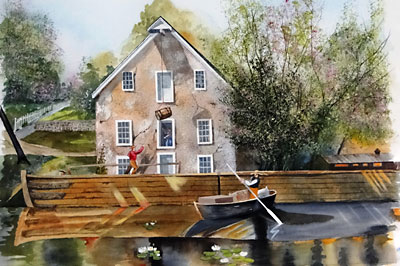
I did another painting of Smith's Store entitled "Spring Thaw". This time I painted it from the front showing the spring thaw and the melting ice along the path of the Homestead House. It looks down the road at the make-shift guardrail made of rough timbers. Once again the importance of Smith's General Store stands out. It was the town "center" because of the necessities that it carried such as seeds for gardens and tools and implements to get the farmers spring garden started. The locals were always glad to see spring come because it brought the melting of the ice on the canal allowing the boats to once again pass freely. Prosperity in town would start once more with the resumption of traffic on the canal.

Later, in another painting there is a lone wagon parked across the street from Smith's General Store and the title of this painting is "No Deliveries Today". It marks the slow decline of things at Waterloo Village at the end of the canal era and the beginning of the railroad. The railroad actually followed the canal because the canal was in the lower lying areas and did not have to travel through the mountains. Instead of making tunnels the train simply followed the path where the canal already went. The advent of the railroad brought the demise to a lot of small villages along its path that had relied on the canal. However, there was a train station in Waterloo that would come and go bringing in goods in a faster fashion and could run all year round, not depending on thawing ice, weather factors or winter freeze-ups.
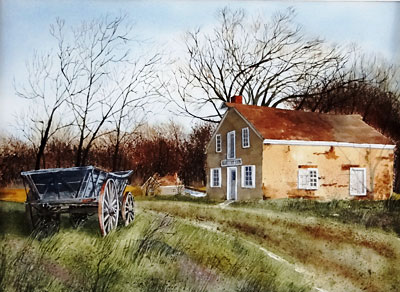
Lets move on down the road where we will come to the "Blacksmith's Shop". This is another main building that saw a lot of activity. The blacksmith was there not only to shoe horses and mules, but he was there to repair farmer's tools and implements. He made hardware for the canal boats and later on just about anything you could use for building such as nails, hinges, and locks for doors. One particular painting I did of the Blacksmith Shop shows a small pony standing outside of the door waiting to get his first pair of shoes, hence the title "New Shoes". In time, this business too, tapered off.
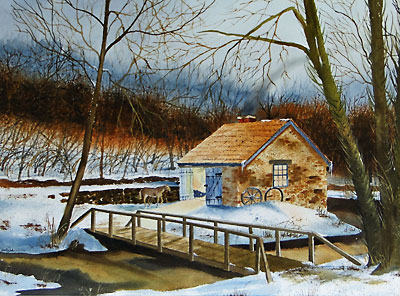
Another painting, "The Last Shoe", depicts the end of the day. The blacksmith is just finishing up his last bit of work before he goes off to supper. The sun sets in the west creating long shadows that cross the canal. The long cool winter nights will prevail until spring.
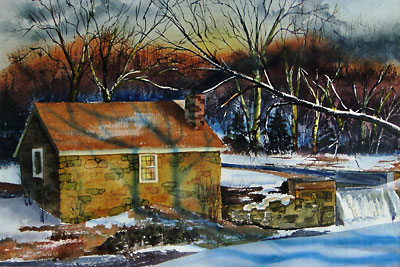
In that area of Waterloo Village, I finished a painting of the Captain's House entitled "Spirit Wind". The house is located almost directly across from Smith's General Store. This house was owned by a canal boat captain. It is said that this house is haunted and there are ghosts. The people who lived in the house claimed they were approached by spirits, and, when the building was renovated, they found a lot of weapons such as swords and muskets that were hidden in a fake wall by the Hessian soldiers. It's possible that these soldiers were hiding within the fake walls, making the people who lived there believe they were hearing ghosts—who knows? However, when you are near the building, it does give you a chilling feeling as if there were actually someone watching you.
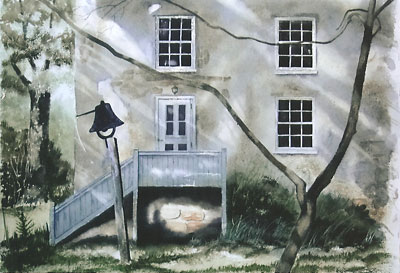
Walking a little further through the village we'll come to the Gristmill. One of my paintings is called "First Grind". It depicts the Mill early in the morning with the first smoke from the wood stove coming from the chimney and the morning sun rising over the hill. There is a farmer with his wagon carrying his first bag of grain into the Mill to be turned into flour. This was not an unusual occurrence and was a way of life for everyone who lived nearby. Years later, the Nabisco Company actually got involved and helped with the restoration of the Gristmill getting it into an operating state. They would bring grain in by the truck loads to grind, making crackers out of the flour which were called Waterloo Gristmill Crackers. They were a special treat and it was wonderful to know that something that good could be ground right in your own backyard. They were on every supermarket shelf in the area, but unfortunately Nabisco stopped baking them.

Next to the Gristmill was the holding pond which was released by various sluices that turned the great wheels inside the Gristmill. When the Mill was quiet and there was not much to grind in the winter, men would cut thick, large chunks of ice off the pond. In the painting I did called "Cutting Ice", which takes place on the mill pond, it illustrates how a horse or sometimes a mule, is waiting at the sled. One man is cutting the ice using a hand saw while one is shoveling the snow off the ice. A third is carrying the ice to the sled ready to be transported. The ice went to resident houses to be put in ice boxes or to Waterloo Lake where there were four ice houses. Ice cutting was one of the major businesses in the area. Producing a tremendous amount of ice, there were also ice houses on Jefferson Lake, Lake Musconetcong and Lake Hopatcong. The ice was also stored and everyone had ice all year round. It is interesting to note that in the spring and summer a lot of the ice was unpacked and sent to the cities like Newark, Dover, and Morristown or loaded on railroad cars and taken into the Poconos into the resort areas for tourists to cool their lemonade on a hot day!

Attached to the Gristmill is a Sawmill, depicted in my painting called "The Sawmill". I took the back of Smith's General Store adding the Sawmill to it and eliminating the canal. I did this because originally the Sawmill was closer to Smith's Store and later became attached to the Gristmill. A new wheel was put in and the water power that was used to turn the Gristmill was also used for the Sawmill.
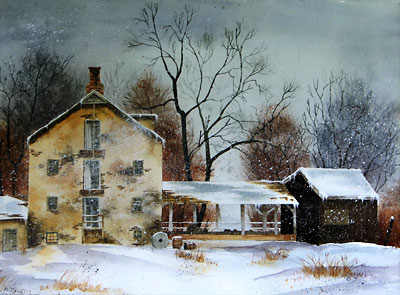
There were a number of buildings in the village that were primarily the homes of the people who lived there. Many of these homes had large carriage houses behind them and, when the village was in its advent of being restored to its original state, some of those big carriage houses were turned into other attractions like the apothecary shop, the herb shop and garden. Behind the Wellington House which was a large white Victorian across the street from Smith's General Store stood such a carriage house. At one time it was home to "Mckays Mighty Circus" a beautiful hand carved Barnum and Bailey three-ring circus. All the characters moved. There were circus tents, trapeze flyers, animals, wagons with animals in them and a parade. Carved by Mr. Mckay, it was a magnificent example of circus life and was on loan to the Village. The circus was so large that it took up an entire floor in the building.
My love affair with Waterloo Village continued through my life and I later became more involved starting in the summer of 1962 when a burgundy Cadillac with a black leather top pulled up in front of my house. Out of the Cadillac stepped an extraordinary handsome and dapper young man. Knocking on my door, I had no idea who he was. After asking if I was David Rush he introduced himself as Percy Leach. Percy was involved in purchasing as many buildings as he could in Waterloo Village where he and his parents actually lived. His primary interest was saving the Village. With more and more people moving away in the 1960s, his goal was to restore the entire village to its former glory. Mr. Leach was in the interior design business lending itself to the project. He had a large office in New York City and an office with his partner, Lou Gualandi on Main Street in Mendham, NJ near the apothecary. I created a large body of art work for Percy and in 1964 his idea had come to fruition and the restoration began. I was fortunate to be there right from the beginning and created art work for more than thirty years for the village. As a result, Percy and I became very good friends. A lot of the ideas for paintings were turned into post cards and sold at Smith's General Store and visitors who came to view the village could now take something away with them as a reminder of their trip. It raised money for the restoration and was a wonderful thing to me to have been able to help with the project and the village that I continued to love.
The Friends of Waterloo held a Harvest Moon Festival on October 12, 2011. I was selected as the Featured Artist at this event to help the Friends of Waterloo with the restoration of the Gristmill and Blacksmith Shop roofs. They also used my paintings to create prints and part of the money made from my paintings went to the restoration process. We raised $8,000 one night at a fundraiser in the Waterloo Museum, located behind the Meeting House. Though Percy Leach and Lou Gualandi have passed away, it feels good that I am still able to help in the preservation of Waterloo Village and to continue the dream of Mr. Leach and Mr. Gualandi.
The work continues with more paintings of Waterloo coming from my mind, soul and brush. I hope to have them available soon. My prints can be purchased from the website of Friends of Waterloo with all the money going directly to the restoration.
I will continue to paint for many more years and look forward to the day when Waterloo is brought back to what it was originally.
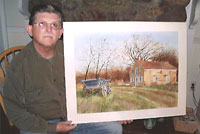
Artist David John Rush of Byram Township, holds his Waterloo Village painting "No Deliveries Today". In the painting stands a lone wagon parked across the street from Smith's General Store at Waterloo Village. "Waterloo Village has always been a part of my life" explained Mr. Rush. He went on. "As a young child, my parents often took me there and the impressions it left upon me stuck. So much so, that I became involved years later creating a large body of art work for Waterloo and eventually helping to raise funds towards its restoration, My dream is to see it returned to its original state".
Mr. Rush will be exhibiting at the Performing Arts Center at Sussex Community College from Saturday, August 25 through Saturday, October 20, 2012 with dual exhibits following at the MAYO Performing Arts Center in Morristown, NJ and the Sussex County Library starting in November and ending after the first of the year. Scheduled for a shows in 2013 are the Madison Public Library in February, the Chester Library in July with other venues pending.
You can contact the artist at 862-324-5299 or visit his website.